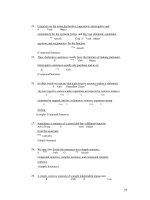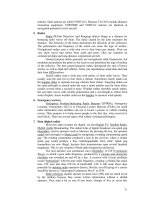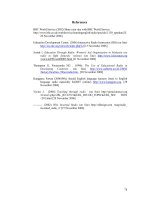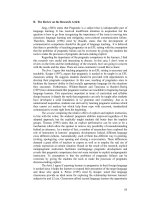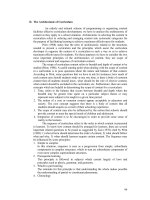TEACHING AND LEARNING SCHEDULER SYSTEM
Bạn đang xem bản rút gọn của tài liệu. Xem và tải ngay bản đầy đủ của tài liệu tại đây (1.46 MB, 41 trang )
Header Page 1 of 113.
VIETNAM NATIONAL UNIVERSITY, HANOI
UNIVERSITY OF ENGINEERING AND TECHNOLOGY
Hua Viet Ngoc
TEACHING AND LEARNING
SCHEDULER SYSTEM
Major: Computer Science
HA NOI - 2015
Footer Page 1 of 113.
`i
Header Page 2 of 113.
VIETNAM NATIONAL UNIVERSITY, HANOI
UNIVERSITY OF ENGINEERING AND TECHNOLOGY
Hua Viet Ngoc
TEACHING AND LEARNING
SCHEDULER SYSTEM
Major: Computer Science
Supervisor: PhD Truong Anh Hoang
HA NOI - 2015
Footer Page 2 of 113.
`ii
Header Page 3 of 113.
AUTHORSHIP
“I hereby declare that the work contained in this thesis is of my own and has not been
previously submitted for a degree or diploma at this or any other higher education
institution. To the best of my knowledge and belief, the thesis contains no materials
previously published or written by another person except where due reference or
acknowledgement is made.”
Signature:………………………………………………
Footer Page 3 of 113.
`iii
Header Page 4 of 113.
SUPERVISOR’S APPROVAL
“I hereby approve that the thesis in its current form is ready for committee
examination as a requirement for the Bachelor of Computer Science degree at the
University of Engineering and Technology.”
Signature:………………………………………………
Footer Page 4 of 113.
`iv
Header Page 5 of 113.
ACKNOWLEDGEMENT
I would like to express my sincere gratitude to PhD Truong Anh Hoang, who helped
me a lot in the process of implementing this thesis.
I would like to also thank some my friends in K56CA - University of Engineering and
Technology and Framgia Company. They also support me to complete my thesis.
I greatly appreciate the following organizations: Information Technology Department,
the University of Engineering and Technology
Footer Page 5 of 113.
`v
Header Page 6 of 113.
ABSTRACT
Currently, the volume of teaching is increasing, the complexity of the process of
assigning teaching schedule so that rational and efficient as well as satisfying many
binding conditions has prompted raises a system can solve the problems mentioned
above. My proposal is to build a friendly system, easy to use for everyone but may
allow custom attributes for building complex an optimal timetable.
My system is divided into 2 parts: the client (front-end) is a website with a friendly
GUI, which allows CRUD data and builds constraints with the timetable; the server
(back-end) will be the data processing center and find an optimal timetable.
In my system, the server use a scheduling system is FET (an open source free
timetabling software), so most of the results of this system depend on the FET. After a
period of testing, I found this system can solve a complex timetable in an acceptable
time even with a university scale.
Overall, this system can solve these problems in practice, however to be able to apply
immediately, it needs to be further improved because there are still some limitations,
as well as to the involvement of multiple parties to conduct tests more systematically.
Footer Page 6 of 113.
`vi
Header Page 7 of 113.
TABLE OF CONTENTS
List of Figures ........................................................................................................... ix
List of Tables .............................................................................................................. x
Abbreviations ............................................................................................................ xi
INTRODUCTION ..................................................................................................... 1
1.1 Motivation ........................................................................................................... 1
1.2 Contributions and thesis overview...................................................................... 1
RELATED WORK .................................................................................................... 3
2.1 Some scheduling software .................................................................................. 3
2.2 FET ..................................................................................................................... 4
2.2.1 Brief history for FET ....................................................................................... 4
2.2.2 FET Features ................................................................................................. 4
2.2.3 FET Algorithms ............................................................................................ 5
2.2.4 FET's role in this system ............................................................................... 7
2.3 Ruby on Rails framework ................................................................................... 7
2.3.1 Ruby language............................................................................................... 8
2.3.2 MVC – Model-View-Controller ................................................................... 8
2.3.3 REST – REpresentational State Transfer ...................................................... 9
2.3.4 ORM – Object-relational mapping ............................................................. 10
2.3.5 Asset pipeline .............................................................................................. 10
2.4 Some other technologies ................................................................................... 11
OUR SYSTEM ......................................................................................................... 12
3.1 Requirements .................................................................................................... 12
3.2 Interactive with FET ......................................................................................... 13
3.3 Use-case diagram .............................................................................................. 14
3.4 Model and Database.......................................................................................... 17
3.5 Controller .......................................................................................................... 20
3.6 View .................................................................................................................. 21
RESULT ................................................................................................................... 26
Footer Page 7 of 113.
`vii
Header Page 8 of 113.
4.1 Results ............................................................................................................... 26
4.2 Comparisons ...................................................................................................... 28
CONCLUSIONS ...................................................................................................... 29
5.1 Conclusions ....................................................................................................... 29
5.2 Future works ...................................................................................................... 29
REFERENCES ........................................................................................................ 30
Footer Page 8 of 113.
`viii
Header Page 9 of 113.
List of Figures
Figure 2.1: A typical collaboration of the MVC components ..................................... 9
Figure 3.1: A detailed diagram of MVC in Rails ...................................................... 13
Figure 3.2: Interactive with FET ............................................................................... 14
Figure 3.3: Use-case diagram (overview) ................................................................. 15
Figure 3.4: Activity diagram for import data from external files .............................. 16
Figure 3.5: Model design for group User .................................................................. 17
Figure 3.6: Model design for group Data .................................................................. 18
Figure 3.7: Model design for group Constraint ......................................................... 19
Figure 3.8: Listing Lecturers ..................................................................................... 22
Figure 3.9: Listing Room (mobile resolution) ........................................................... 22
Figure 3.10: Edit day (mobile resolution) ................................................................. 23
Figure 3.11: Edit course (mobile resolution) ............................................................. 23
Figure 3.12: Break Times constraint ......................................................................... 24
Figure 3.13: Non-overlap Courses constraint ............................................................ 24
Figure 3.14: Space Courses constraint ...................................................................... 25
Figure 3.15: Lecturer constraint ................................................................................ 25
Figure 4.1: Screen for manager home ....................................................................... 27
Figure 4.2: Screen for timetable ................................................................................ 27
Footer Page 9 of 113.
`ix
Header Page 10 of 113.
List of Tables
Table 3.1: RESTful routes provided by the Subjects resource .................................. 20
Table 4.1: Time to process of scheduling task .......................................................... 26
Footer Page 10 of 113.
`x
Header Page 11 of 113.
ABBREVIATIONS
CRUD
Create, read, update and delete
CSV
Comma-separated values
FET
(name of free timetable software)
GUI
Graphics user interface
MVC
Model-View-Controller
ORM
Object-relational mapping
REST
Representational state transfer
ROR
Ruby on Rails framework
Footer Page 11 of 113.
`xi
Header Page 12 of 113.
Chapter 1
INTRODUCTION
1.1 Motivation
Nowadays, teaching activities at the university has become more complex because
many different reasons: the number of classes, courses, lecturers, classrooms, along
with a variety of different binding conditions on time for other work of the lecturers,
bound in the courses of the same class are non-overlap,.... It makes building a
timetable becomes extremely difficult.
Unfortunately, this issue has been resolved manually in many schools and universities.
It cannot thoroughly solve the above-mentioned constraints, as well as the control,
statistics, management becomes difficult. This motivated me to build a system to solve
the problem on, create a better solution now.
In fact, in some places I know, they still do manually, but not encounter too many
obstacles. Simply because of their classrooms so much, so arranging a timetable not
good, still can satisfy the basic conditions. But with more complex constraints, or the
facilities are not redundant, the timetable construction is still very difficult to manually
resolve. Even with the large number of classrooms, there will be many vacant
classrooms in many periods, this is wasteful. If we can control, we can use for other
useful purposes. So it is clear that we need a system that can solve this issue.
1.2 Contributions and thesis overview
The purpose of this thesis is to present how to build a system as described above and
my main contribution was the development of this system. We will present detail in
later
The rest of this thesis is organized to as follows:
Footer Page 12 of 113.
`1
Header Page 13 of 113.
Chapter 2 presents some work related to the construction of this system include: using
an open source software for scheduling (FET), Ruby on Rails (ROR) framework and
some knowledge related to website development
Chapter 3 will present full of design, architecture, the how it work of the system.
Chapter 4 and Chapter 5 will be the results and conclusions
Footer Page 13 of 113.
`2
Header Page 14 of 113.
Chapter 2
RELATED WORK
2.1 Some scheduling software
Today, scheduling problem is not a new issue. So sure there was a lot of scheduling
software has been developed around the world. Before building the system, we should
find out through some current software:
UniTime ( /> FET - Free Timetabling Software ( /> Mimosa Scheduling Software ( /> Lantiv Scheduling Studio 7 ( />Above is some current scheduling software, however, Mimosa Scheduling Software
and Lantiv Scheduling Studio 7 software are not free software, as they are inclined to
create and manage manually rather than with the automatic scheduling with
conditions. UniTime and FET are open source software, automatic scheduling with
constraints. In addition, there also are many other similar software only are most of
them are offline and commercial software. Through the process of research, I think
that they still do not really resemble my system. I am building a system with userfriendly interface, easy to use; work through the internet environment (although the
schedule may belong to some individuals, but constraints can come from many sides,
as well as other information should be shared). So I decided to build a new system.
However I noticed FET was designed for the purpose to expand, FET can solve pretty
good core issue. FET is also open source software, so I decided to use the FET as part
of the system.
Footer Page 14 of 113.
`3
Header Page 15 of 113.
2.2 FET
In this system, one of the most important pieces is the task scheduling. This is a
difficult task. I decided do not build from scratch. And right there is a lot of software
has solved this problem, but I am particularly attentive to FET.
FET is open source free software for automatically scheduling the timetable of a
school, high-school or university. It uses a fast and efficient timetabling algorithm. It is
licensed under the GNU Affero General Public License version 3 or later. [1]
Usually, FET is able to solve a complicated timetable in maximum 5-20 minutes. For
simpler timetables, it may take a shorter time, under 5 minutes (in some cases, a matter
of seconds). For extremely difficult timetables, it may take a longer time, a matter of
hours. [1]
2.2.1 Brief history for FET
On 31 October 2002 - Liviu Lalescu started the project. The algorithm was
genetic, very inefficient.
On 19 March 2006 - Volker Dirr joined the project. He reported that his
difficult data file could not be solved by FET, but could be solved by other
software, and insisted to continue the search for a better algorithm for FET.
On 24 June 2007 - The current efficient heuristic FET-5 algorithm was found marked a leap in the effectiveness of the algorithm
FET is still being developed and supported until today
2.2.2 FET Features
FET is written in C ++, so it can ensure the performance, rapid implementation
of complex algorithms, build on the Qt framework, install and compile via
Cmake. Platform independent implementation, allowing running on
GNU/Linux, Windows, Mac and any system that Qt supports.
Flexible modular XML format for the input file, allowing editing with an XML
editor or by hand (besides FET interface)
The resulted timetables are exported into XML formats
Each constraint has a weight percentage, from 0.0% to 100.0% (but some
special constraints are allowed to have only 100% weight percentage)
Footer Page 15 of 113.
`4
Header Page 16 of 113.
A large and flexible palette of time constraints:
o Break periods
o For teacher(s):
Not available periods
Max/min days per week
Max hours daily/continuously
o For students (sets):
Not available periods
Max days per week
Max hours daily/continuously
Min hours daily
o For an activity or a set of activities/sub-activities:
A set of preferred starting times
Min/max days between them
Consecutive, ordered, grouped (for 2 or 3 (sub)activities)
Not overlapping
A large and flexible palette of space constraints:
o Room not available periods
o For teacher(s):
Home room(s)
o For students (sets):
Home room(s)
o Preferred room(s):
For a subject
For an activity tag
In addition, FET can solve some other constraints, but I think that no actually
need should not put in here
2.2.3 FET Algorithms [1]
FET uses algorithms developed through several stages as well as uses some other
software too, so it is very complex. So I just summarize the main idea of the algorithm
through references
FET uses a heuristic algorithm, placing the activities in turn, starting with the most
difficult ones. If it cannot find a solution, the algorithm swaps activities recursively if
Footer Page 16 of 113.
`5
Header Page 17 of 113.
that is possible in order to make space for a new activity or, in extreme cases,
backtracks and switches order of evaluation.
The algorithm is heuristic (Lalescu named it "recursive swapping").
Input: a set of activities A_1...A_n and the constraints.
Output: a set of times TA_1...TA_n (the time slot of each activity. Rooms are excluded
here, for simplicity. We solve with time and rooms similarly, and then combine them
into final result). The algorithm must put each activity at a time slot, respecting
constraints. Each TA_i is between 0 (T_1) and max_time_slots-1 (T_m).
Constraints:
C1) Basic: a list of pairs of activities which cannot be simultaneous (for instance, A_1
and A_2, because they have the same teacher or the same students);
C2) Lots of other constraints (excluded here, for simplicity).
The timetabling algorithm ("recursive swapping"), though it might be related to the
algorithm known as "ejection chain"):
1) Sort activities, most difficult first. Not critical step, but speeds up the
algorithm maybe 10 times or more. (It means we choose activities have most
constraints – or least selections)
2) Try to place each activity (A_i) in an allowed time slot, following the above
order, one at a time. Search for an available slot (T_j) for A_i, in which this
activity can be placed respecting the constraints. If more slots are available,
choose a random one. If none is available, do recursive swapping:
o 2a) For each time slot T_j, consider what happens if you put A_i into
T_j. There will be a list of other activities which don't agree with this
move (for instance, activity A_k is on the same slot T_j and has the same
teacher or same students as A_i). Keep a list of conflicting activities for
each time slot T_j.
o 2b) Choose a slot (T_j) with lowest number of conflicting activities. Say
the list of activities in this slot contains 3 activities: A_p, A_q, A_r.
Footer Page 17 of 113.
`6
Header Page 18 of 113.
o 2c) Place A_i at T_j and make A_p, A_q, A_r unallocated.
o 2d) Recursively try to place A_p, A_q, A_r (if the level of recursion is
not too large, say 14, and if the total number of recursive calls counted
since step (2) on A_i began is not too large, say 2*n), as in step (2).
o 2e) If successfully placed A_p, A_q, A_r, return with success, otherwise
try other time slots (go to step (2 b) and choose the next best time slot).
o 2f) If all (or a reasonable number of) time slots were tried
unsuccessfully, return without success.
o 2g) If we are at level 0, and we had no success in placing A_i, place it
like in steps (2 b) and (2 c), but without recursion. We have now 3 - 1 =
2 more activities to place. Go to step (2) (some methods to avoid cycling
are used here).
2.2.4 FET's role in this system
As described above, FET can solve partial workload in this system but not all. FET is
not easy for everyone, not entirely consistent with the teaching at university (I find it
suitable for high school schedules). So we need to change, rebuild several
mechanisms. And even when using FET, the workload must perform for building
systems remains big.
2.3 Ruby on Rails framework (ROR)
This system is actually a website, so I need to choose a framework to build. There are
many frameworks (on many languages: PHP, Python, Ruby, Java....) to choose from
but I chose ROR (Ruby languages) because some advantages:
ROR is an open-source web framework that‟s optimized for programmer
happiness and sustainable productivity. It lets you write beautiful code by
favoring convention over configuration. [2]
ROR can build a website quickly because it was staged for basic tasks.
ROR is designed with many advantages
o Ruby language:
Object-oriented programming
Footer Page 18 of 113.
`7
Header Page 19 of 113.
Functional programming
Meta-programming
o Rails framework:
MVC
REST
ORM
o Having asset pipeline
o There are many good security mechanism
Although the system design can be completely independent of the tools for building it
but my thesis is not only the design that presents the process of building up, so
selection of platform or other technologies is very important.
Using framework, designs, patterns or techniques will reduce a lot of effort while
ensuring the necessary requirements. I am pleased to present several characteristics of
the rails.
2.3.1 Ruby language
Ruby is a dynamic, open source programming language with a focus on simplicity and
productivity. It has an elegant syntax that is natural to read and easy to write.
Rails were built on the Ruby programming language. This is a modern language with
syntax style is quite natural and understandable. There is a great community support
and development lib (called gem).
Ruby is full of functions necessary for the development of an application: Objectoriented programming, Functional programming, Meta-programming...
2.3.2 MVC – Model-View-Controller
Model–view–controller (MVC) is a software architectural pattern for implementing
user interfaces. It divides a given software application into three interconnected parts,
so as to separate internal representations of information from the ways that information
is presented to or accepted from the user. [4]
Footer Page 19 of 113.
`8
Header Page 20 of 113.
The Controller is what connects the views to the model. A controller can send
commands to CRUD the model. It can also send commands to its associated
view to change the view's presentation of the model.
The Model is where you should keep your data model, the algorithms.
The View requests information from the model that it uses to generate an output
representation to the user. View visualize the data (the UI)
Figure 2.1: A typical collaboration of the MVC components [4]
MVC is widely used in website development. The clear dividing functions, tasks and
methods of interact as above figures makes the architecture of the website coherently,
clear, easy to control and manage.
2.3.3 REST – REpresentational State Transfer
REST is an architectural style for developing distributed, networked systems and
software applications such as the World Wide Web and web applications. Although
REST theory is rather abstract, in the context of Rails applications REST means that
most application components are modeled as resources that can be created, read,
updated, and deleted - operations that correspond both to the CRUD operations of
relational databases and to the four fundamental HTTP request methods: POST, GET,
PATCH, and DELETE.
As a Rails application developer, the RESTful style of development helps you make
choices about which controllers and actions to write: you simply structure the
application using resources that get created, read, updated, and deleted.
Footer Page 20 of 113.
`9
Header Page 21 of 113.
2.3.4 ORM – Object-relational mapping
Object-relational mapping, commonly referred to as its abbreviation ORM, is a
technique that connects the rich objects of an application to tables in a relational
database management system. Using ORM, the properties and relationships of the
objects in an application can be easily stored and retrieved from a database without
writing SQL statements directly and with less overall database access code.
In Rails, there is an implementation of the Active Record pattern which itself is a
description of an Object Relational Mapping system. Active Record gives us several
mechanisms, the most important being the ability to:
Represent models and their data.
Represent associations between these models.
Represent inheritance hierarchies through related models.
Validate models before they get persisted to the database.
Perform database operations in an object-oriented fashion.
2.3.5 Asset pipeline
In Rails, there are three principal features to understand: asset directories, manifest
files, and preprocessor engines:
Asset directories: there are three canonical directories for static assets, each
with its own purpose:
o app/assets: assets specific to the present application
o lib/assets: assets for libraries written by our development team
o vendor/assets: assets from third-party vendors
Manifest files: This is a mechanism of Rails can combine all javascript files into
one, all css into one, increasing efficiency when loading a web page
Preprocessor engines: This is a Rails mechanism to help process a file in a
series engine. For example: file „foobar.js.erb.coffee‟ gets run through both
CoffeeScript (a language same javascript) and ERb (embedded ruby) (with the
code running from right to left, i.e., CoffeeScript first).
Footer Page 21 of 113.
`10
Header Page 22 of 113.
With asset pipeline, the results are optimized to be efficient in a production application
but we can work with multiple nicely formatted files in development. The result is the
best of both worlds: convenience in development and efficiency in production.
2.4 Some other technologies
Outside of FET and ROR, I have studied and used some of technologies, techniques
and protocols later (because they are also quite popular today, so I just mentioned, but
will not say much about it):
HTTP protocol: is an application protocol for distributed, collaborative,
hypermedia information systems. HTTP is used popularly in World Wide Web
HTML: is a revision of the Hypertext Markup Language, the standard
programming language for describing the contents and appearance of Web
pages.
CSS: (Cascading Style Sheet) is a plain text file format used for formatting
content on web pages.
JavaScript: is an interpreted programming or script language (often used in the
client side to manipulate with DOM - Document Object Model)
Git: is a distributed revision control system with an emphasis on speed, data
integrity, and support for distributed, non-linear workflows.
Heroku: a cloud application platform that deploy web apps.
Footer Page 22 of 113.
`11
Header Page 23 of 113.
Chapter 3
OUR SYSTEM
3.1 Requirements
The system should be developed to ensure the following requirements:
About user and authorities:
There are 2 user types: Manager and Lecturer
Lecturer:
o Can edit/update profile
o Can see useful data (lecturers, subjects, courses, timetable ...)
o Can add, edit, remove personal constraints (busy time, max periods
continuous/daily, ...)
Manager:
o Can edit/update profile
o Can add, remove Lecturer model
o Can CRUD other data (time (periods), space (rooms), subjects, courses,
...)
o Can create constraints (break times, unavailable rooms in some periods,
non-overlap courses ...)
o Can control generating timetable
About GUI:
Friendly, easy to use
Intuitive, good interaction
Responsive web (good view in mobile)
About functions:
Manipulation of data to work correctly, ensure data integrity when changes
Footer Page 23 of 113.
`12
Header Page 24 of 113.
Data can import from external file (CSV, Excel ...). This makes moving data
from another place to the system conveniently
Solving timetable has to be an acceptable time (or find a good solution in a
determined interval). The configuration can adjustment flexibility in the process
generating timetable
Can search, change data easily
3.2 Interactive with FET
We will start building the basic architecture for the system starting from the processing
of requests from users, and how to communicate with FET:
Figure 3.1: A detailed diagram of MVC in Rails. [3]
The above figure is the basic process of processing the request is sent from the client
according to the MVC pattern. To communicate with the FET, we will build a
Controller to create FET input (XML format) from data in the model. Then we active
FET (C++ program) via command line to generate timetable. FET output is also XML
Footer Page 24 of 113.
`13
Header Page 25 of 113.
files. We will parse output XML files to transform into the model, make a complete
timetable. The figure below describe more clearly:
ORM
Database
Model
(2) Get data to
create input for FET
(7) Save timetable
information
(1) Send a request to
generate timetable
Controller
(3) Create
Input (XML format)
(4) Active via
command line
Manager
(6) Parse XML file
to transform into
model
(5) Solve by FET
FET
(5) Solve by FET
Output (XML format)
Figure 3.2: Interactive with FET
Also, when working with the FET, this requested requires time. So we should use
multithreading techniques to other requests still work when FET is running.
3.3 Use-case diagram
First, let's consider the overall design for use-case diagrams generally.
We has 2 types of user: lecturer and manager, both 2 and inherited from the user, the
user has manipulate the basic login / logout and to use sessions and cookies to
remember user (we should care to security issues, Rails has available security
mechanisms pretty good against common hacking type, including passwords or tokens
remember are hashed before writing to the database, data encryption values in cookie,
use SSH, ....). Let see more clearly illustrated in below:
Footer Page 25 of 113.
`14




